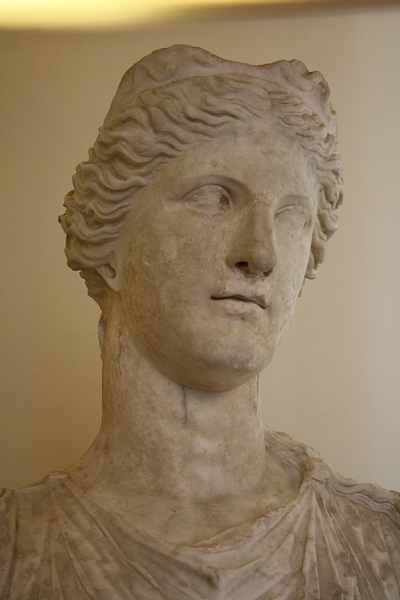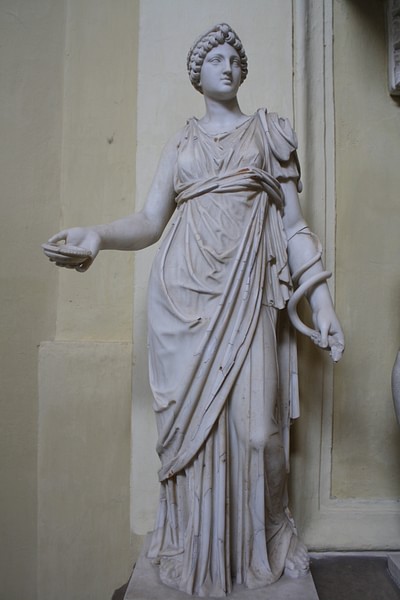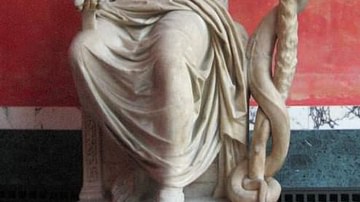Modern medicine has its origin in the ancient world. The oldest civilizations used magic and herbs to cure their sick people, but they also used religion to free them from harm and to protect their health. The medical care of today has its roots in ancient Greece. With the introduction of Asklepios and Hygieia in Athens, there sprouted a very important healing cult that existed from about 500 BCE until 500 CE. Hygieia plays a very unusual role in Greek religion because of her unclear identity. She was connected with Asklepios in the 5th century BCE, and together they became the most famous healing couple within the Greek and Roman world. One of the main problems is the identity of Hygieia. She has been given several names, which cross each other all the time through modern literature from the late 19th century CE. Terms like goddess, personification, abstraction and extension of Asklepios are but a few of the labels given to her. It is an interesting question why modern scientists and historians alike use different names for Hygieia, when ancient sources literally state that is she is a goddess. An example is the first Oath of Hippokrates, which states: I swear by Apollo, the healer, Asklepios, Hygieia, and Panakeia, and I take to witness all the gods, all the goddesses, to keep according to my ability and my judgment, the following Oath and agreement. (Oath of Hippokrates)
So the conclusion is that we have to discuss definitions of personification. What is personification? Does it mean the anthropomorphic representation of lifeless things? Which stages of personification can one define? According to Stafford, health is one of the physiological states to be personified in the ancient world, perhaps most closely paralleled by Sleep (Hypnos/Somnus), who also had strong associations with healing cults, and who could even be represented asleep at Hygieia's feet. Further, what relation exists between Greek concepts like prosōpopoiia and ēthopoiia and does it coincide with the Latin personificare?
Secondly, we have to ask ourselves the question what are deities. Are the Greek gods immortal and living on Mount Olympos? Do they drink nectar and eat ambrosia, while playing men being invisible but still omnipresent? It is important to make a distinction between Olympian deities and Greek gods, because mythology is fundamentally something other than religion.
Thirdly, there is the discussion of mythology. Although she hasn't got much mythology, she is linked with several deities such as Apollo, Athena, and Asklepios, and also to the Egyptian goddess Isis Medica, whose functions are the same of that of Asklepios and Hygieia. There is also a link with the Roman Bona Dea. Her function does make it possible to identify her with Hygieia. Further, identification can be made based on the fact that Bona Dea was worshipped as Bonae Daea Hygiae, and a connection is given with Minerva, the Roman counterpart of Athena. Minerva was also worshipped as a healing deity by the name of Minerva Medica. There is no question about the nature of Athena, Apollo, Isis, and Bona Dea. These figures are worshipped as deities. Asklepios himself is a difficult figure. He started as a mortal, then a demigod, thirdly a minor deity, until he became the most important medical deity of the Greek world. If we look at comparative mythology, does this make Hygieia more important?
Finally, we will discuss the historical context. Hygieia had her own cult already in the 7th and 6th centuries BCE, which has been recognized by the Delphic Oracle; after it develops into a supra-local cult in Greece and Rome, where it is incorporated into the religious traditions of Asklepios, the god of Medicine. When in 429 and 427 BCE a plague breaks out in Athens, it did not take long before Hygieia and Asklepios were brought into Athens. The year of their introduction was 420 BCE.

According to Parker, the 5th century BCE is a century of religious renewal. This century is characterized by the introduction of new cults, when 'new gods' come to Athens. There are three changes that can be observed in the 5th century BCE: first, the importance of small cults, secondly the addition of new epithets to ancient deities, and third, the introduction of "foreign divinities". An example of the enlargement of smaller cults is the cult of Athena Nike whose altar adorned the Acropolis since the mid-6th century BCE. This cult, however, only about emanates around 450 BCE in celebration of beating the Delish- Attic Sea Alliance in Persia. Other examples of religious renewal are the building of temples to Poseidon in Sounion and Nemesis Rhamnous between approximately 450 and 430 BCE.
The second innovation is characterized by adding new epithets to existing gods, because the Athenians found it quite common for deities to unite them with abstractions. Examples are deities such as Artemis Aristoboule, Artemis Eukleia and Zeus Eleutherios. Finally, "foreign divinities" were introduced, which the Greeks called xenikoi theoi. This term cannot simply be translated as "foreign divinities", along with the modern understanding of the term "foreign" because for an Athenian, a man of Epidauros was also a xenikos. The crucial division is not between non-Greek and Greek deities, but between the deities traditionally honored in public cults and the rest. According to Herodotus the gods are the same everywhere, just with different names. Examples of such deities are Dionysus, Bendis, Pan and Asklepios. Besides a cult of Hygieia, there is still a cult of Athena Hygieia. Plutarch tells the following story in his Perikles about how a strange accident happened in the course of building, which showed that the goddess was not averse to the work, but was aiding and co-operating to bring it to perfection.
One of the artificers, the quickest and the handiest workman among them all, with a slip of his foot fell down from a great height, and lay in a miserable condition, the physicians having no hope of his recovery. When Pericles was in distress about this, the goddess appeared to him at night in a dream, and ordered a course of treatment, which he applied, and in a short time and with great ease cured the man. And upon this occasion it was that he set up a brass statue of Athena Hygeia, in the citadel near the altar, which they say was there before. But it was Phidias who wrought the goddess's image in gold, and he has his name inscribed on the pedestal as the workman of it. (Plutarchus, Perikles 13.8.)
The shrine of Athena Hygieia on the west side of the Acropolis is very important in the celebration of the Panathenaia and the altar by the Athenians first established. Garland argues that the most important healing sanctuary belongs to Athena Hygieia, until Asklepios makes his appearance in Athens. In mythology, Hygieia is the daughter, sister, or wife of Asklepios. A further explanation is that the Homeric gods are no longer sufficient and that they are unable to satisfy the population, so new saving deities have to appear. Hygieia is occasionally associated with Amphiaraos, specifically in Oropos, its principal place of worship. She appears several times alone or together with this hero. Pausanias says that the fourth part of the great altar of the Amphiareion was shared with Aphrodite, Panakeia, Iaso, Hygieia and Athena Hygeias. Stafford claims that the sharing of the altar by Hygieia affects the Athenian cult Amphiaraos after Oropos transferred to Athens after the Battle of Chaironeia, and where Hygieia would have a place in the Athenian Amphiareion in 330 BCE and beyond. Deities indeed could displace each other. Another example is Apollo displacing Gaia as an oracle deity.
Another context is advocated, when told that people could stay healthy by living sensibly. Athena is also the goddess of wisdom and thus a logical connection. Bell adds that Hygieia is mainly the goddess of physical health, but that her function also includes mental health and that she also can be associated with Athena Hygieia. A third idea is, according to Warren, that it is Athena, who teaches Asklepios how to bring back the dead to life. Finally, Compton gives a fourth explanation, namely that ancient conceptions of health and illness do not distinguish between mental and physical ailments. Thus can Athena Hygieia and Hygieia easily can be associated with each other. Previous ideas go against the idea that the relationship between Athena Hygieia and Hygieia merely is coincidental, because the cult of Asklepios is not introduced the end of the 5th century BCE, and Hygieia does not appear previously as a separate figure in literature or art. Wroth indicates that Athena used the epithet "Hygieia" to strengthen her medical skills. This would be a correct assumption, when the declining satisfaction about deities is considered. The goddesses could exist separately from one another. A more convincing argument for a clearer distinction between Athena Hygieia and Hygieia is given by Stafford, when she quotes Farnell. Farnell said that around 330 BCE, sacrifices still are offered to Athena Hygieia. This contradicts the claim that the Hygieia from the Telemachus monument is a development of the Athenian Athena Hygieia, and that after 420 BCE no further mention is made of Athena Hygieia as previously argued by Mitchell Boyask. Farnell himself does not mention the year 330 BCE. It appears that his position is based on the celebration of the Panathenaia. It is indicated that all the dedications to Athena dating from a later period after 420 BCE, but he doesn't give a clear argument. Stafford qualifies this with the fact that in 330 BCE offerings to Athena Hygieia were made during the Small Panathenaia and that these operations are recorded by the tax levied on the newly discovered field within the 4th century BCE Oropos.
Personally, I follow the argument that Hygieia had her own regional cult in the 7th and 6th centuries BCE, but that Hygieia really got famous when she was brought to Athens around 420 BCE. The Telemachus Monument from the early 4th century BCE confirms this theory. Furthermore, Hygieia gets her own altar in the Asklepieion next to Asklepios. In addition, there is already a cult of Athena Hygieia in 420 BCE that would fade after the arrival of Asklepios and Hygieia, but there is still a small revival when in 330 BCE during the Small Panathenaia people sacrificed to her. The cult of Hygieia and Athena Hygieia may have passed each other, so that Athena Hygieia as a separate figure was no longer needed. The introduction and development of the cult of Hygieia can be placed in the idea that the 5th century BCE was a century of religious innovation, where old gods got new epithets, small cults became more important, and "new" deities entered the Greek religion.
Conclusion
We can say after this short essay that Hygieia was very important in her role to protect the health of ancient Greeks, first in Athens, than the rest of the Greco-Roman world. Her connection with Asklepios strengthens her position. The most important example is the Oath of Hippokrates in which she is mentioned after Asklepios. She has a place within the most important triad of healing gods, Apollo and Asklepios. As Athena Hygieia she had to protect the Athenians. Athena Hygieia had a counterpart in Minerva Medica, and due to the comparative mythology with Isis Medica and Bona Dea Hygieae, her role as goddess is enhanced. Further, she was viewed as the most important partner of Asklepios in his cults all over Greece en Italy. She was honored from the 7th century BCE until the 5th century CE and even today we have inherited her name in our word hygiene. Health in antiquity was as important as it is today.







